MICRO DWELLINGS
 Micro Dwellings, Oslo 2005
Micro Dwellings, Oslo 2005Introduction:
MICRO DWELLINGS is a system for making low cost dwellings of variable sizes for any number of persons.
It consists of movable housing modules that can form different configurations on land, on water and under water. The system allows for a diversity of materials as well as changes and adaptations.
The MICRO DWELLINGS are modular, can be scaled up and down, and expand and grow together with other systems into small communities. The MICRO DWELLINGS can be built onto rooftops of existing buildings or be suspended from a bridge or a wall. The modules can be mounted on wheels to become mobile or be connected to form floating constructions. As is the case with the version shown in this manual, they can also be made as watertight, amphibian houses that can be completely submerged or partly elevated to the water surface Most functions will be built into walls, and furniture, household equipment etc. will be provided by movable elements that change functions during the day. Supply modules can be mounted on the outside of the main modules.
The MICRO DWELLINGS are able to reflect changes in life, e.g. people moving in and out, the arrival of children, etc, as it is easy to add to the construction in stages. If people want to live together they can simply let their dwellings grow together, likewise, it is easy to separate modules and move them if desirable. The MICRO DWELLINGS in themselves do not define a social constellation, but only provide the basic equipment so that persons can configure their own social setting.
The present version of the system is made of cheap steel plates and can be constructed by anybody who knows how to weld.
 Submerged, Copenhagen 2006
Submerged, Copenhagen 2006Background:
Current house building techniques in the western world have to a large extent failed to incorporate knowledge of geometry that enables lightweight and durable constructions which can be produced at a fraction of the cost of conventional houses. The lack of innovation in this field can be ascribed to the enormous economic interests that are tied to real estate. Challenging habitual conceptions in this area is seen as a risk not worth undertaking. However, the present situation creates considerable inequalities, where people with even average incomes cant afford buying or renting a place to live in major cities and their suburbs. As a result, monoculture prevails and people with lower incomes are forced into the margins or into finding alternative solutions.
Making dwellings available for less money would reduce the need for high incomes in order to afford living. This in turn could free time for other activities than money-generating work, something that could have a positive social impact Concentrations of power limit person’s access to land by the force of among other things the notion of ownership. Furthermore, the use of land is highly regulated. Living on, or under water, is a realistic alternative to living on land. Underwater houses are especially interesting, as they are hardly described in the existing building codes in western countries and thus difficult to control

Construction:
The MICRO DWELLINGS consist of equal-sized units in the form of truncated octahedrons. Truncated octahedra will fill space when combined. They can also be joined with a variety of platonic and archimedic shapes into numerous combinations. The truncated octahedron is a plate-stable construction, which means that the construction once the plates are assembled, need no further reinforcement, as the plates themselves provide the support (in the real world this depends on the size of the construction and the strength of the materials). The strength is a combination of the plate stability and the spaceframe that occurs once the plates are assembled along the edges.
The materials can be varied, but durability, strength and low cost are crucial parameters that have to be balanced with each other. Each unit can easily be scaled up or down. The plates can be welded together or a non-destructive assembly method can be used if one wants to be able to take the construction apart and reassemble it This version is welded in steel with reinforcing frames, which enables the construction to withstand a pressure of up to 2 atmospheres, corresponding to a depth of 10 meters. However, a placement 1 – 5 meters under surface level is sufficient since at this depth, light still penetrates the water and access is easier. By welding the steel plates one gets a bearing and watertight construction at the same time.
The plates are treated with epoxy on the outside and anticorrosive paint on the inside and finally insulated with plates of polyethylene foam.
 Door with lock. Windows
and doors also function as docking ports with other modules.
Door with lock. Windows
and doors also function as docking ports with other modules. Detachable legs mounted on hydraulic jacks.
Detachable legs mounted on hydraulic jacks.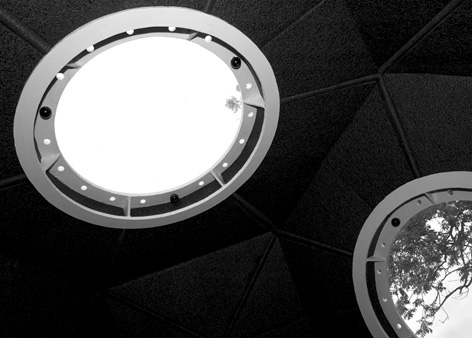 Windows, prepared for pressurised environments.
Windows, prepared for pressurised environments. Interior walls with reinforcing frames.
Interior walls with reinforcing frames. Interior with combined table and bed.
Interior with combined table and bed. Zaragossa, Spain, 2006
Zaragossa, Spain, 2006 Three units combined.
Three units combined. Truncated octahedra, truncated tetrahedra and cuboctahedra combined.
Truncated octahedra, truncated tetrahedra and cuboctahedra combined.Extensions:
The compressed version of a MICRO DWELLING shown in this manual contains very simple equipment for living However, a dwelling consisting of three modules combined would allow for separating functions as follows:
Eat
Kitchen area, including micro-greenhouse with hydroponics systems for supplementing daily household with lettuce, tomatoes, herbs etc. Floating MICRO DWELLINGS can have their own fish farms, chicken farms and floating gardens attached outdoors.
Shit
This module contains the toilet and shower. In addition, all wet appliances such as water drain and supply, hot water tanks etc. can be brought together here. For off-shore living, tanks for water storage and waste water can also be installed. All tanks can be mounted on the outside to save space. Grey water can be led to the micro-greenhouse and purified by the plants. A micro-desalination plant can be installed for deriving drinking water from sea water. The toilet can be a compost toilet that uses no water.
Sleep
A unit for sleeping as well as for relaxation and social activities during daytime. Movable furniture in the form of polyethylene modules serve as sofas, beds, and tables according to needs. Bed linen, duvets etc. can be kept in a net during daytime. Flexible screens can divide the space to create privacy if wanted In addition, smaller modules of various shapes can be attached, if there is a need for more space, e.g. extra rooms, storage, etc.
An energy unit could be hooked on to the MICRO DWELLINGS, consisting of for example micro-windmills, solar panels and solar heat systems, heat pumps etc.
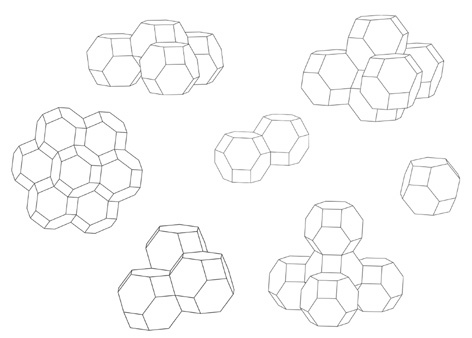 Some ways of combining the MICRO DWELLINGS.
Some ways of combining the MICRO DWELLINGS.

Technical specifications:
Basic module:
Height: 2, 3 meters
Width: 2,4 meters
Component list:
8 hexagonal plates and 6 square plates in 4 mm steel, edge length 831 mm
Legs and frames in 5 x 1.2 mm steel
3 hydraulic jacks
3 circular steel plates Ø 60 cm
3 steel rings, outer diameter 70 cm/inner 60 cm
3 steel rings, outer diameter 70 cm/inner 80 cm
3 polycarbonate plates, Ø 75 cm10 mm
Bakelite knobs, nuts and bolts
Polyethylene foam, 50 mm
Rubber strips
Epoxy
Anticorrosive paint
 MICRO DWELLINGS, London 2006
MICRO DWELLINGS, London 2006




























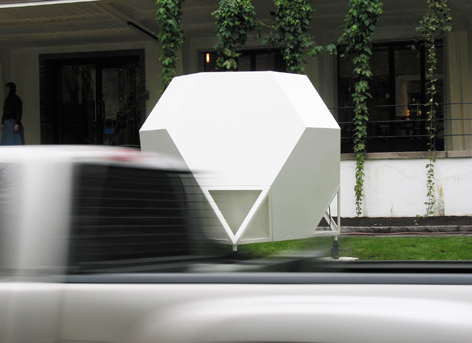



 Talking Cities, Urban drift, Essen, Germany, 2006
Talking Cities, Urban drift, Essen, Germany, 2006

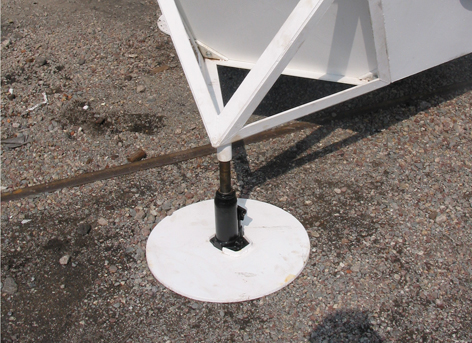
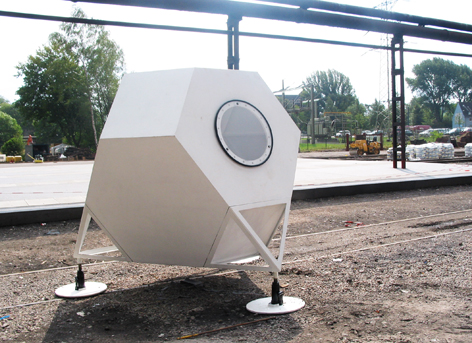

 Building modules in Copenhagen 2005
Building modules in Copenhagen 2005